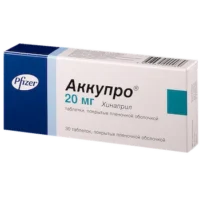Description
Atorvasterol (Atorvastatin) Coated Tablets 40 mg. №30
Composition
Each tablet contains 40 mg of atorvastatin.
Mechanism of Action
Atorvastatin works by inhibiting HMG-CoA reductase, an enzyme involved in cholesterol synthesis. This action leads to a reduction in LDL cholesterol levels, thereby decreasing the risk of atherosclerosis and cardiovascular events.
Pharmacological Properties
Atorvastatin is effective in lowering LDL cholesterol levels and has been shown to reduce the incidence of cardiovascular events. It plays a crucial role in the prevention of heart attacks and strokes.
Indications for Use
Atorvastatin is indicated for the treatment of hypercholesterolemia and the prevention of cardiovascular diseases. It is particularly beneficial in reducing LDL cholesterol levels and decreasing the risk of heart attacks and strokes.
Contraindications
Avoid using atorvastatin in patients with active liver disease or unexplained persistent elevations of serum transaminases. It is contraindicated in pregnant and breastfeeding women due to potential risks to the fetus or infant.
Side Effects
Common side effects of atorvastatin may include muscle pain and weakness. If you experience any signs of allergic reactions such as rash, swelling, or difficulty breathing, seek immediate medical attention. Regular monitoring of liver function tests is recommended to detect any adverse effects on the liver.
Usage Instructions
Take one tablet orally with or without food, as prescribed by your healthcare provider. It is essential to maintain a healthy diet and exercise regimen while using atorvastatin to maximize its benefits.
Benefits Compared to Analogues
Atorvastatin has demonstrated significant benefits in reducing LDL cholesterol and improving cardiovascular outcomes compared to other statins. Its effectiveness in primary and secondary prevention of cardiovascular diseases has been well-established in clinical trials.
Suitable Patient Groups
Atorvastatin can be used in various patient groups, including adults, elderly individuals, and certain pediatric populations. Dosage adjustments may be necessary based on individual characteristics such as age, gender, and concurrent medications.
Storage and Shelf Life
Store atorvastatin tablets in a cool, dry place away from direct sunlight. Check the packaging for the expiration date and do not use the product beyond its shelf life.
Packaging Description
Each package contains 30 coated tablets of Atorvasterol, with each tablet containing 40 mg of atorvastatin. The packaging is designed to ensure the stability and integrity of the tablets.
Clinical Evidence and Proven Effectiveness
Atorvastatin, the active ingredient in Atorvasterol tablets, has been extensively studied in clinical trials. Research has consistently shown its efficacy in lowering LDL cholesterol levels and reducing the risk of cardiovascular events. Notably, a study published in the New England Journal of Medicine highlighted the significant benefits of atorvastatin in high-risk patients.





